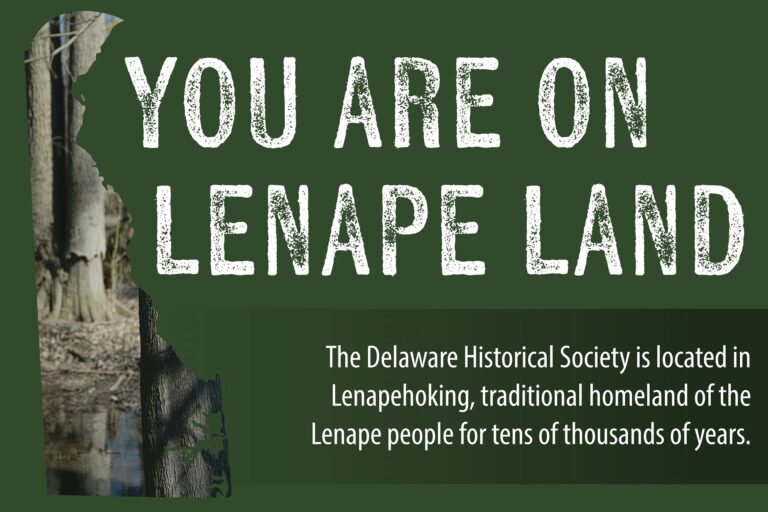Past Exhibitions
The First State at the Front: WWI & the Road to Victorious Peace
November 16, 2017 – September 17, 2019
Delaware History Museum
DeWees/Thronson Foundations Gallery, 2nd Floor
A special exhibition commemorating the centennial of the United States’ entry into World War I and focusing on contributions of Delaware and its people, both on the Front in Europe and at home.
Almost as Fast as Birds Can Fly: The Railroad in Delaware
December 15, 2016 – March 30, 2017
Old Town Hall
A panel exhibition produced by the Delaware Historical Society and selection of artifacts form the Society’s own collections showcasing the significance and contributions of the railroad to life in Delaware.
Sterling Selections: Silver from the DHS Collection
November 5, 2015 – January 20, 2017
Delaware History Museum
DeWees/Thronson Foundations Gallery, 2nd Floor
The inaugural exhibition in the DeWees/Thronson Foundations Gallery following an extensive renovation of the Delaware History Museum campus. This special exhibition featured over 300 pieces of Delaware silver from the Society’s collections.
Delaware Century Farm Portraits
November 5, 2015 – December 18, 2015
Old Town Hall
Inaugural exhibition in the newly restored Poole Gallery space in Old Town Hall featuring ten original oil paintings of Delaware’s century farms (family farms that have been in continuous operation for over a century) by Milford artist, Mark S. Reeve.
Forging Faith Building Freedom: African American Faith Experiences in Delaware, 1800-1980
September 26, 2013 – June 14, 2014
Delaware History Museum
Produced with curatorial input from Dr. Lewis Baldwin, Professor of religious studies at Vanderbilt University and authority on the history of black churches in the United States, this special exhibition celebrated the history of African American faith traditions in Delaware and their contribution to religious development in the United States.
Little Italy, Big Festival
May-September, 2020
Willingtown Square Gallery
In the early 1880’s, immigrants from the newly unified Republic of Italy began appearing in northern Delaware, mostly in Wilmington, searching for work. Many immigrants moved on to other American towns or returned to their homeland after a specific job was completed. However, a few saw something they liked in the rolling hills of northern Delaware and, despite a language barrier and unfamiliar culture, chose to stay and lay down roots. Most were from southern Italy, an agrarian and economically stagnant region in the decades following Italian unification. They came to America, the Land of Opportunity, in search of material prosperity.
Eight identifiable pockets of settlement developed in and near Wilmington in the early 20th century. • They gradually assimilated into broader American society as the 20th century progressed, except for the largest enclave on what was called “The Hill” due to its high elevation on Wilmington’s west side. Today it is known as “Little Italy”. The founding of St. Anthony’s Parish and Church solidified the cohesion of the local Italian community there and led to the formation of the regionally famous Carnevale, the St. Anthony’s Italian Festival.
This exhibit celebrated “un villagio vivace e unico”, a vibrant and unique village. It included various materials derived from the Delaware Historical Society’s library and museum collection, as well as loans and gifts from St. Anthony’s Parish and friends in the local community.
Delaware Yesterday, Delaware Today 1962-2012
August 18, 2012 – June 15, 2013
Delaware History Museum
A collaboration with award-winning regional magazine, Delaware Today, this exhibition celebrated the fiftieth birthday of the magazine and the best of Delaware life, history, and culture through the Delaware Historical Society’s diverse collections.
A Circle of Friendships United by Ideals: The Girl Scouts of the Chesapeake Bay
February 16, 2012 – June 16, 2012
Delaware History Museum
This special loan exhibition, guest curated by museum consultant and author Jenifer Grindle Dolde, celebrated both the centennial of girl scouting in the United States and the 50th anniversary of the Girl Scouts of the Chesapeake Bay.
Play Ball! Baseball in Delaware
Fall 2012
Delaware History Museum
Play Ball! celebrated the origins, early years, and 20th century development of the National Pastime in the First State. It featured a very rare original scorebook from games played by the Lenapi Baseball Club of New Castle in 1866. Other highlights included original, handwritten rules and by-laws created by local businessmen forming their own team, rare photographs of local amateur clubs, and baseballs, bats, gloves, and novelty items. One of the baseballs in the exhibit was signed by Legendary Baseball Hall of Famer William Julius “Judy” Johnson, who played for the Hilldale Stars of the Negro Leagues in the 1920s. Johnson lived in Marshallton, Delaware from 1934 until his death in 1989 and was one of the greatest third basemen of his era. The home field of the current Wilmington Blue Rocks is named Judy Johnson Field in his honor.
Steppin' Out Under the Stars
March 31, 2011 – December 31, 2011
Delaware History Museum
An exhibition planned and opened in conjunction with the launch of the World Café Live in in the historic and freshly renovated Queen Theater building in the 500 block of Market Street. The exhibition celebrated downtown Wilmington’s history as a center of nightlife and lively entertainment during the 20th twentieth century.
Almost as Fast as Birds Can Fly: The Railroad in Delaware History
May 7, 2010 – February 19, 2011
An exhibition focusing on how the development of the railroad shaped Delaware’s history as an industrial and transportation hub during the nineteenth and twentieth centuries and featuring items from the Jackson & Sharp, Harlan & Hollingsworth, and Pullman Car Companies.
Frontier Delaware
December 18, 2009 – March 13, 2010
Delaware History Museum
A travelling exhibition created by the Swedish American Historical Museum in Philadelphia that focused on the early Swedish and Dutch settlers in Delaware. The exhibition was hosted at three venues: The Swedish American Historical Museum, the New Jersey State Museum, and the Delaware Historical Society.
Emily Bissell and the Christmas Seal
Winter, 2007
Willingtown Square Gallery
Emily Bissell was born in Wilmington, Delaware on May 31, 1861. She spent her entire life in Wilmington as a social worker, philanthropist, humanitarian, author, and activist. She founded the West End Neighborhood House in Wilmington which served many community based functions in immigrant Irish and German families. Interestingly, she was also an outspoken anti-suffragist in the early 1900s. In 1907, Bissell was drawn to the cause of helping those suffering from Tuberculosis. She was intrigued by an experiment then occurring in Denmark for issuing stamps to raise money in the fight against TB. She is best known for introducing the same idea, what we now know as the Christmas Seal to Delaware and the United States. She designed the first stamp herself. Well known illustrator, Howard Pyle, designed the second stamp. Bissell passed away on March 8th, 1948.




SOCIAL
Facebook
Instagram
YouTube
Email